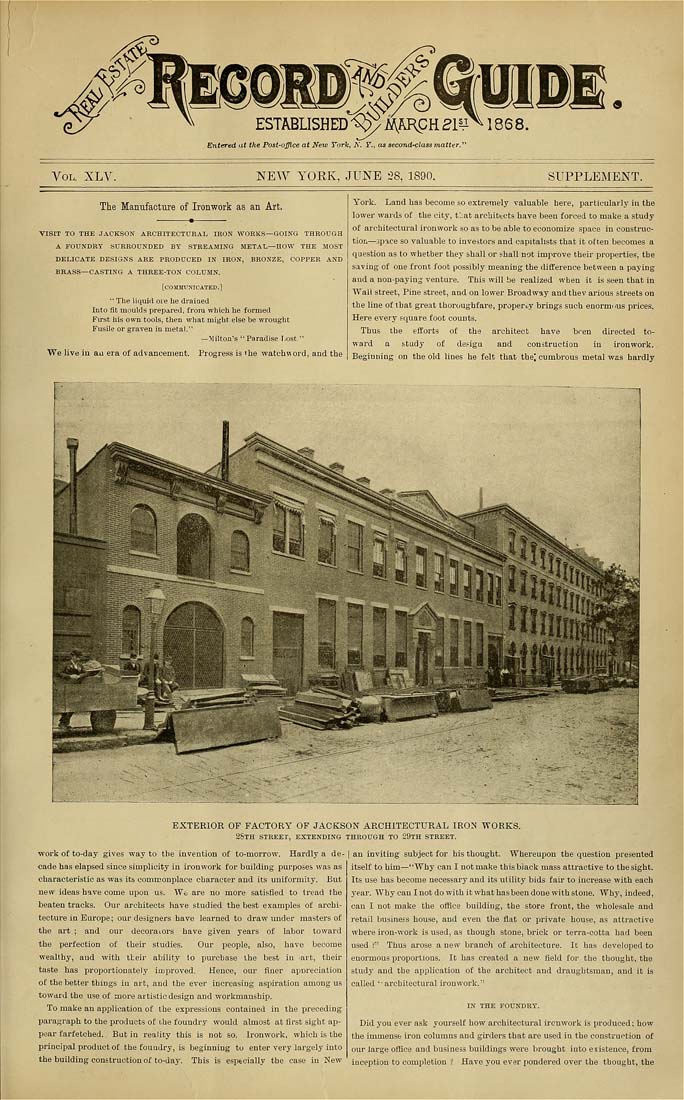Columbia University Libraries Digital Collections: The Real Estate Record
Use your browser's Print function to print these pages.
Real estate record and builders' guide: v. 45, no. 1163: June 28, 1890: Supplement

Text version:
Please note: this text may be incomplete. For more information about this OCR, view About OCR text.
'Mil ESTABUSHED'Wi\ARpH^i¥^ 1868. Entered at the Post-ofiice at New York, K. Y.. as second-class matter," Vol. XLV. NEW YOKK, JUNE 28, 1890. SUPPLEMENT. The Manufactm-e of Ironwork as an Art, VISIT TO THE J-iCKSON ARCHITECTURAL IRON WORKS—GOING THROUGH A FOUNDRY SURROUNDED BY STREAMING METAL—HOW THE MOST DELICATE DESIGNS ARE PRODUCED IN IRON, .BRONZE, COPPER AND BRASS—CASTING A THREE-ION COLUMN. [CO 11 MP NIC ATBD .1 " The liquid ore he draiaed Into fit moulds prepai'ed, from wliich he formed First his own tools, then what might else he wrought Fiisile or graven in metaL" —Milton's "Paradise Lost." We live iu au era of advancement. Progress is ihe watclinord, and the York. Land has become so extremely valuable here, partieularly iu the lower waids of the city, tL-.at architects have been forced to make a study of architectural ironwork so as to be able to economi?e space in construc- tioii-space so valuable to investors and capitalists tbat it often becomes a question as to whether they shall or shall not improve their properties, the saving of oue front foot possibly meaning the difference betn eeu a paying and a nou-payius venture. This will be realized when it is seeu that iu Wall street. Pine street, and on lower Broadway and thev arious streets on the liue of tbat great thoroughfare, properuy brings such euornuois prices. Here every square foot counts. Thus lbe efforts of the architect have been directed to¬ ward a study of de>iga aud construction in irouwork. Begiuuing on the old hues Ue folt that the) cumbrous metal was hardly EXTERIOR OF FACTORY OF JACKSON ARCHITECTURAL IRON WORKS, 2STH STREET, EXTENDING THROUGH TO 29tH STREET. I work of to-day gives way to the invention of to-moiTOw. Hardly a de¬ cade has elapsed since siuipliclty in ironwork for building purposes was as characteristic as was its commonplace cbaracter aud its uniformity. But new ideas have come upon us. Wc are no more satisfied to ti'ead the beaten tracks. Our architects have studied the best examples of archi¬ tecture in Europe; our designers have learned to draw under masters of the art ; and our decorators have giveu years of labor toward the perfection of their studies. Our people, also, have become wealthy, aud wifch Lteir ability lo purchase lhe best in -art, their taste has proportionately iiuproved. Heiice, our finer apwreciatiou of tbe better things iu art, aud the ever inereasiug aspiration among us toward the use of more artistic design and workmanship. To make an apjilication of lhe espressions contained in the preceding paragraph to the products of tha foundry would almost at first sight ap¬ pear farfetched,. But iu reality this is not so. Ironwork, which is the principal product of the foundry, is beginning to enter very largely iuto the huilding construction of to-day. This is especially the case in New an inviting subject for his thought. Whereupon the question presented itself to him—"Why can I not make this biack mass attractive to the sight. Its use has become necessary and its ulility bids fail' to increase with each year. Whycaulnotdowithitwhathasbeendonewitbstone. Why, iudeed, can I not make the offlce buildiug, the store front, tbe wholesale and retail business house, aud even the flat or private bouse, as attractive where iron-work is used, as though stone, brick or terra-cotta bad been used ;" Thus arose anew brancb of Architecture. It bas developed to enormous proportions. It has created a new fleld for the thought, the study and the application of the architect and draughtsman, and it is called 'architectural irouwork." IN THE FOUNDRY, Did you ever ask yourself bow architectural ironwork is produced; how the immensfj iron columns and gir(lei"S that are used iu the construction of our large office and business buildings were brought iuto esistence, frora inception to completion ^ Have you ever pondered over the thought, tbe